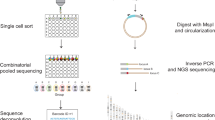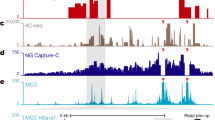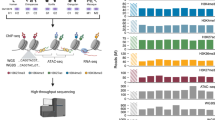Abstract
We mapped regulatory loci for nearly all protein-coding genes in mammals using comparative genomic hybridization and expression array measurements from a panel of mouse–hamster radiation hybrid cell lines. The large number of breaks in the mouse chromosomes and the dense genotyping of the panel allowed extremely sharp mapping of loci. As the regulatory loci result from extra gene dosage, we call them copy number expression quantitative trait loci, or ceQTLs. The −2log10P support interval for the ceQTLs was <150 kb, containing an average of <2–3 genes. We identified 29,769 trans ceQTLs with −log10P > 4, including 13 hotspots each regulating >100 genes in trans. Further, this work identifies 2,761 trans ceQTLs harboring no known genes, and provides evidence for a mode of gene expression autoregulation specific to the X chromosome.
This is a preview of subscription content, access via your institution
Access options
Subscribe to this journal
Receive 12 print issues and online access
$209.00 per year
only $17.42 per issue
Buy this article
- Purchase on Springer Link
- Instant access to full article PDF
Prices may be subject to local taxes which are calculated during checkout







Similar content being viewed by others
Accession codes
Change history
28 April 2008
In the version of this article initially published, the scale was inadvertently omitted from the bottom left portion of Figure 4. This error has been corrected in the PDF version of the article.
References
Jansen, R.C. & Nap, J.P. Genetical genomics: the added value from segregation. Trends Genet. 17, 388–391 (2001).
Brem, R.B., Yvert, G., Clinton, R. & Kruglyak, L. Genetic dissection of transcriptional regulation in budding yeast. Science 296, 752–755 (2002).
Wayne, M.L. & McIntyre, L.M. Combining mapping and arraying: an approach to candidate gene identification. Proc. Natl. Acad. Sci. USA 99, 14903–14906 (2002).
Schadt, E.E. et al. Genetics of gene expression surveyed in maize, mouse and man. Nature 422, 297–302 (2003).
Kirst, M. et al. Coordinated genetic regulation of growth and lignin revealed by quantitative trait locus analysis of cDNA microarray data in an interspecific backcross of eucalyptus. Plant Physiol. 135, 2368–2378 (2004).
Morley, M. et al. Genetic analysis of genome-wide variation in human gene expression. Nature 430, 743–747 (2004).
Dixon, A.L. et al. A genome-wide association study of global gene expression. Nat. Genet. 39, 1202–1207 (2007).
Goring, H.H. et al. Discovery of expression QTLs using large-scale transcriptional profiling in human lymphocytes. Nat. Genet. 39, 1208–1216 (2007).
Stranger, B.E. et al. Population genomics of human gene expression. Nat. Genet. 39, 1217–1224 (2007).
Bystrykh, L. et al. Uncovering regulatory pathways that affect hematopoietic stem cell function using 'genetical genomics'. Nat. Genet. 37, 225–232 (2005).
Hubner, N. et al. Integrated transcriptional profiling and linkage analysis for identification of genes underlying disease. Nat. Genet. 37, 243–253 (2005).
Chesler, E.J. et al. Complex trait analysis of gene expression uncovers polygenic and pleiotropic networks that modulate nervous system function. Nat. Genet. 37, 233–242 (2005).
Goss, S.J. & Harris, H. New method for mapping genes in human chromosomes. Nature 255, 680–684 (1975).
McCarthy, L.C. Whole genome radiation hybrid mapping. Trends Genet. 12, 491–493 (1996).
Olivier, M. et al. A high-resolution radiation hybrid map of the human genome draft sequence. Science 291, 1298–1302 (2001).
McCarthy, L.C. et al. A first-generation whole genome-radiation hybrid map spanning the mouse genome. Genome Res. 7, 1153–1161 (1997).
Avner, P. et al. A radiation hybrid transcript map of the mouse genome. Nat. Genet. 29, 194–200 (2001).
Hudson, T.J. et al. A radiation hybrid map of mouse genes. Nat. Genet. 29, 201–205 (2001).
Peirce, J.L., Lu, L., Gu, J., Silver, L.M. & Williams, R.W. A new set of BXD recombinant inbred lines from advanced intercross populations in mice. BMC Genet. 5, 7 (2004).
Behboudi, A. et al. The functional significance of absence: the chromosomal segment harboring Tp53 is absent from the T55 rat radiation hybrid mapping panel. Genomics 79, 844–848 (2002).
Jansen, R.C. Maximum likelihood in a generalized linear finite mixture model by using the EM algorithm. Biometrics 49, 227–231 (1993).
Redner, R.A. & Walker, H.F. Mixture densities, maximum likelihood and the EM algorithm. SIAM Rev. 26, 195–239 (1984).
Eisen, M.B., Spellman, P.T., Brown, P.O. & Botstein, D. Cluster analysis and display of genome-wide expression patterns. Proc. Natl. Acad. Sci. USA 95, 14863–14868 (1998).
Saldanha, A.J. Java Treeview–extensible visualization of microarray data. Bioinformatics 20, 3246–3248 (2004).
Hughes, T.R. et al. Expression profiling using microarrays fabricated by an ink-jet oligonucleotide synthesizer. Nat. Biotechnol. 19, 342–347 (2001).
Rockman, M.V. & Kruglyak, L. Genetics of global gene expression. Nat. Rev. Genet. 7, 862–872 (2006).
Churchill, G.A. & Doerge, R.W. Empirical threshold values for quantitative trait mapping. Genetics 138, 963–971 (1994).
Brem, R.B., Storey, J.D., Whittle, J. & Kruglyak, L. Genetic interactions between polymorphisms that affect gene expression in yeast. Nature 436, 701–703 (2005).
Storey, J.D., Akey, J.M. & Kruglyak, L. Multiple locus linkage analysis of genomewide expression in yeast. PLoS Biol. 3, e267 (2005).
Benjamini, Y. & Hochberg, Y. Controlling the false discovery rate—a practical and powerful approach to multiple testing. J. Roy. Statist. Soc. Ser. B. Methodological 57, 289–300 (1995).
Benjamini, Y. & Yekutieli, D. The control of the false-discovery rate in multiple testing under dependency. Ann. Stat. 29, 1165–1188 (2001).
Carlborg, O. et al. Methodological aspects of the genetic dissection of gene expression. Bioinformatics 21, 2383–2393 (2005).
Prandini, P. et al. Natural gene-expression variation in Down syndrome modulates the outcome of gene-dosage imbalance. Am. J. Hum. Genet. 81, 252–263 (2007).
Yoshida, K., Yoshitomo-Nakagawa, K., Seki, N., Sasaki, M. & Sugano, S. Cloning, expression analysis, and chromosomal localization of BH-protocadherin (PCDH7), a novel member of the cadherin superfamily. Genomics 49, 458–461 (1998).
Heard, E. & Disteche, C.M. Dosage compensation in mammals: fine-tuning the expression of the X chromosome. Genes Dev. 20, 1848–1867 (2006).
Yvert, G. et al. Trans-acting regulatory variation in Saccharomyces cerevisiae and the role of transcription factors. Nat. Genet. 35, 57–64 (2003).
Lehmann, E.L. & Romano, J.P. Testing Statistical Hypotheses (Springer, New York, 2005).
Bartel, D.P. MicroRNAs: genomics, biogenesis, mechanism and function. Cell 116, 281–297 (2004).
Lim, L.P. et al. Microarray analysis shows that some microRNAs downregulate large numbers of target mRNAs. Nature 433, 769–773 (2005).
Pillai, R.S. MicroRNA function: multiple mechanisms for a tiny RNA? RNA 11, 1753–1761 (2005).
Cusick, M.E., Klitgord, N., Vidal, M. & Hill, D.E. Interactome: gateway into systems biology. Hum. Mol. Genet. 14 (Spec No. 2), R171–R181 (2005).
Perlstein, E.O., Ruderfer, D.M., Roberts, D.C., Schreiber, S.L. & Kruglyak, L. Genetic basis of individual differences in the response to small-molecule drugs in yeast. Nat. Genet. 39, 496–502 (2007).
Author information
Authors and Affiliations
Contributions
C.C.P., A.S., A.H.K. and C.J.F. carried out the experiments; S.A., J.S.B., A.L., R.T.W. and T.W. did the statistical and computational analysis; C.C.P., A.J.L., R.M.L., K.L. and D.J.S. wrote the paper; D.J.S. devised the study.
Corresponding author
Supplementary information
Supplementary Text and Figures
Supplementary Methods, Supplementary Table 1, Supplementary Figures 1–6 (PDF 3215 kb)
Rights and permissions
About this article
Cite this article
Park, C., Ahn, S., Bloom, J. et al. Fine mapping of regulatory loci for mammalian gene expression using radiation hybrids. Nat Genet 40, 421–429 (2008). https://doi.org/10.1038/ng.113
Received:
Accepted:
Published:
Issue Date:
DOI: https://doi.org/10.1038/ng.113
This article is cited by
-
Construction of two whole genome radiation hybrid panels for dromedary (Camelus dromedarius): 5000RAD and 15000RAD
Scientific Reports (2018)
-
Genetic screening reveals a link between Wnt signaling and antitubulin drugs
The Pharmacogenomics Journal (2016)
-
Cilia, Wnt signaling, and the cytoskeleton
Cilia (2012)
-
Genotype and expression analysis of two inbred mouse strains and two derived congenic strains suggest that most gene expression is trans regulated and sensitive to genetic background
BMC Genomics (2010)
-
GREAT improves functional interpretation of cis-regulatory regions
Nature Biotechnology (2010)



